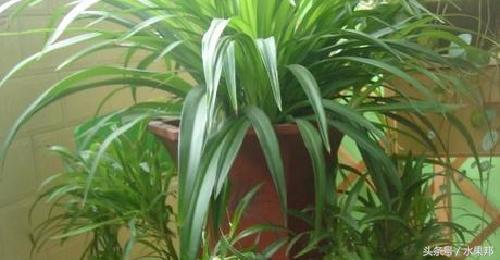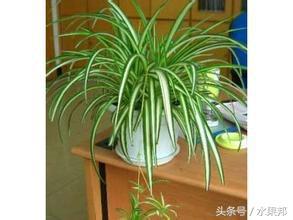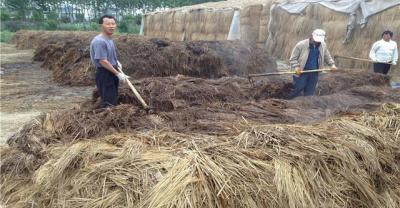There are hanging orchids at home, you need to know these breeding skills!
Hanging orchid has a strong function of absorbing harmful gases, if it is a new house decoration, must put more pots of hanging orchid at home, in order to purify indoor air and absorb formaldehyde emitted by furniture. However, if you do not know the culture method of the hanging orchid, it is easy to raise the hanging orchid to death. Today, I will introduce the breeding method of the hanging orchid.

The Culture method of Cymbidium
Cymbidium is a perennial evergreen perennial herbaceous flower with various forms, strong shade tolerance and easy management. It is often used to hang potted plants for indoor decoration or garden setting. The following points should be mastered in its management:
Lighting: hanging orchid likes semi-overcast environment. Spring and autumn should avoid the strong direct sun, the summer sun is particularly strong, can only see some oblique light in the morning and evening, during the day need to cover 50% of the sun 70%, otherwise it will make the leaf tip dry, especially the flower and leaf varieties, more afraid of strong sunlight, Phnom Penh orchids grow more beautiful in places with weak light, yellow edges are more obvious, leaves are brighter. But it should be more sunny in winter in order to keep the leaves tender and fresh green. The family potted orchid should be placed in front of the south window, otherwise the leaves will lose their luster and even wither.
Temperature: the optimum growth temperature of the orchid is 15 mi 25 degrees Celsius. If the winter temperature is lower than 5 mi 7 degrees Celsius, you should pay attention to cold protection and heat preservation.
Watering: hanging orchid likes the humid environment, always keep the basin soil moist, adequate watering in summer, and spray water on the branches and leaves around noon and in the evening to prevent the leaves from drying up. There is often much dust in the room, such as more dust on the orchid, which not only affects its growth, but also damages the freshness and freshness of the branches and leaves, so we should often spray and wash the branches and leaves to keep them bright and beautiful. Lower withered leaves, yellow leaves should be picked at any time, usually to maintain normal humidity, should not be dry, should not be too wet.

Fertilization: Cymbidium is a more fertilizer-tolerant foliage plant, if the lack of fertilizer and water, it is easy to scorch head aging, leaves yellow, loss of ornamental value. From late spring to early autumn, organic fertilizer can be applied every 10 days, but less nitrogen fertilizer should be applied to Phnom Penh, Jinxin and other mosaic varieties, so as not to fade or even disappear. The retting organic manure such as bone meal and eggshell can be properly applied. After full fermentation, appropriate amount of diluent should be taken and poured once every 10 li for 15 days to make the flowers and leaves bright and bright.
Change the soil and change the basin: in the management, in order to make the stems and leaves luxuriant, the soil and basin should be changed once in March every year. If the basin is deeper and the base fertilizer is more sufficient, the basin can be changed once every two years. When turning the basin, knock the plant out of the basin, cut off the withered roots and excess roots, replace it with a new humus-rich culture soil, and then apply livestock hoof horns or rotten cake fertilizer as base fertilizer. After planting, put the seedlings in a warm and semi-overcast place. The optimum growth temperature of Cymbidium is about 25 ℃. After the plant returns to robust growth, hang the flowerpot under the eaves of the corridor or in an appropriate position in the room. The general height is not to meet, and should pay attention to ventilation.
The breeding method of Cymbidium?
Cymbidium can be propagated by cutting, ramet, sowing and other methods. Cutting and ramet propagation can be carried out at any time from spring to autumn. Cymbidium has strong adaptability and high survival rate, so it is generally easy to reproduce. When cutting, as long as the stolon with new buds is inserted into the soil by 5cm to 10cm, it can take root in about a week, transplant in a pot in about 20 days, and keep it in a cool place with water.

What if the leaves of Cymbidium turn yellow?
The yellowing of the leaves in the process of growth is caused by a variety of reasons:
First, too much fertilizer is applied, which exceeds the requirement of the plant. At the beginning, the leaves were shiny and uneven, the roots rotted and the leaves were yellow. Should stop fertilizing, irrigate more water, or turn the pot to clean the root and replace the new soil.
Second, the basin has not been turned over for a long time. The various nutrient elements in the basin soil have been exhausted, the three elements of nitrogen, phosphorus and potassium have not been replenished in time, the plant is lack of nutrients, and the leaves are yellow and thin. Fertile loam and fertile water should be replaced in time.
Third, although the orchid is a semi-negative flower, it should see more than four hours of astigmatism at least every day, otherwise the chlorophyll will decrease and the leaves will turn yellow.

Fourth, the air permeability and water permeability of basin soil are poor. The long-term accumulation of water in the basin soil makes it difficult for the root system to breathe, which leads to the yellowing of the leaves. The soil should be loosened and moisture should be controlled in time.
Fifth, it is impervious to water for a long time. The roots of Cymbidium lose water, and the lower old leaves turn yellow. It should be watered thoroughly to keep the basin soil warm and moist.
Matters needing attention
The above is the analysis of the main points of the breeding methods of hanging orchids, as long as we grasp the four main points of like shade, often spraying water, fertilizing frequently and changing pots, it is believed that it is easy to cultivate beautiful hanging orchids.
- Prev

The elegant Little Princess "Fairy Fish" Culture Collection of Tropical Fish
Fairy fish, also known as swallow fish, angel, small fairy fish, small fin sailing fish, etc., Riceae fish, native to South America Guiana, Brazil. The fairy fish grows 12-15 centimeters.
- Next

Conservation, management and culture methods and benefits of pocket coconut
Pocket coconut alias Qili bamboo coconut, pocket bamboo, dwarf coconut, dwarf brown, parlor brown, lucky brown, pocket coconut sunflower, pocket brown. Evergreen shrubs, potted plants.
Related
- On the eggshell is a badge full of pride. British Poultry Egg Market and Consumer observation
- British study: 72% of Britons are willing to buy native eggs raised by insects
- Guidelines for friendly egg production revised the increase of space in chicken sheds can not be forced to change feathers and lay eggs.
- Risk of delay in customs clearance Australia suspends lobster exports to China
- Pig semen-the Vector of virus Transmission (4)
- Pig semen-the Vector of virus Transmission (3)
- Five common causes of difficult control of classical swine fever in clinic and their countermeasures
- Foot-and-mouth disease is the most effective way to prevent it!
- PED is the number one killer of piglets and has to be guarded against in autumn and winter.
- What is "yellow fat pig"? Have you ever heard the pig collector talk about "yellow fat pig"?

